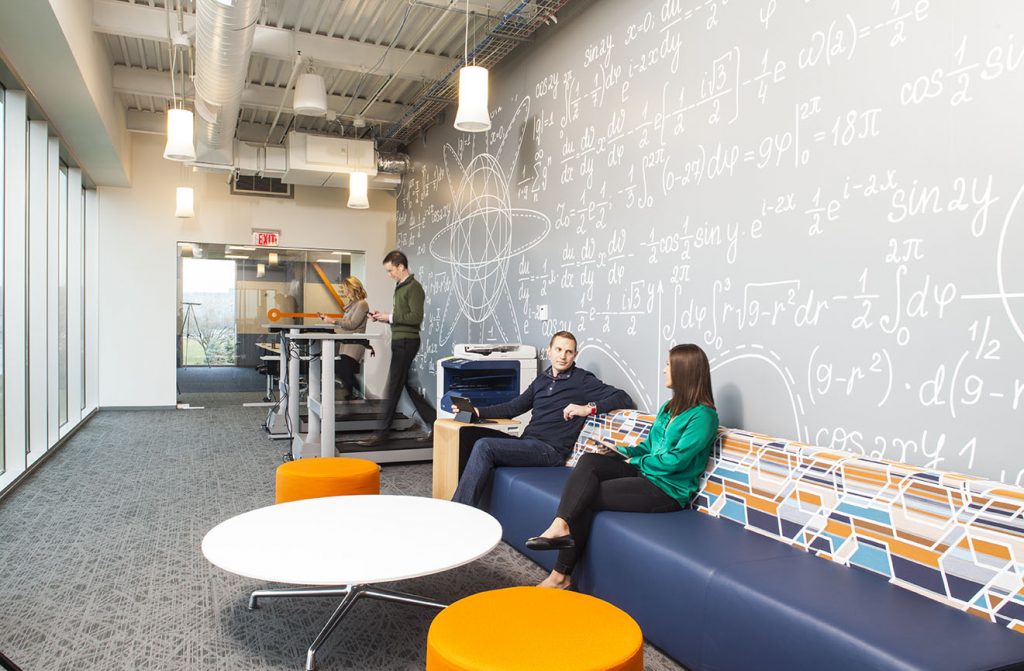
Wellness as a Design Strategy, post Covid-19
In my last post I touched on a few things to consider when we come back to our workplace, one being Health and Wellness. Always a design objective at Fox Architects, it is one that has particular significance today.
Dealing with stress is a big part of wellness. Case in point: my wife has been an educator in the St. Louis Public School System for over 25 years as a classroom teacher, an academic instructional coach, and an assistant principal. It’s a rewarding job, but one that has its challenges. Many times we have discussed the differences between our local school district and SLPS. Here in my neighborhood, most (but not all) of the kids have stable home lives. Contrast that with the kids my wife teaches where there is poverty, frequent moves to new schools and lots of problems my kids and their friends didn’t face. People have varying opinions on why, but the simple reality is, for kids with so many things stressing them out before they walk through the school doors, it’s tremendously difficult to concentrate on learning. Obviously, stress isn’t the only factor, but it’s a major one. Why?
Your mental state significantly impacts your ability to do your best work.
Now that we are in the midst of the COVID-19 pandemic, it’s nearly impossible to escape the daily flood of bad news. Couple that with pre-existing health issues and you have a recipe for increased anxiety, unhappiness, and decreased productivity. However, there is some good news: there are things we can do within our workplace environments that will help. It won’t take away all the hurt, but every little bit counts.
Things you can do to improve health and wellness.
Let’s talk about Cleanliness. It is imperative in our fight against the virus to keep surfaces clean, to wash our hands, and ensure that everything the public touches (doorknobs and fixtures in particular) are sanitized. Beyond this, a clean workplace sends a message – that the organization cares about employees and takes pride in the space’s appearance. Now is the time for Spring Cleaning. Pay attention to the details. Dust…everywhere. Clean all surfaces with cleaning solutions recommended by the CDC. Wash scuff marks off walls or even consider a fresh coat of paint (make sure those painters follow social distancing protocols). A clean workplace is a healthy workplace.
Green is good. I’m referring to plants. Well-cared for plants are a significant contributor to a healthy environment. Maintaining a visual connection with nature – whether plants indoors or the view of a garden outdoors – is a key biophilic component. Plants promote feelings of calm and peace. According to a study in the Journal of Physiological Anthropology, being in proximity to indoor plants helps reduce stress. Plants also clean the air by filtering out pollutants. At Taliesin in Spring Green, Frank Lloyd Wright used to send the apprentices out into the woods to cut branches and bring the greenery inside the drafting room. The trusses, materials, colors and plants transformed the space into a forest. We have an instinctual connection with nature and well designed and cared-for indoor plantings can brighten any space.
Daylight improves your overall mental state. I don’t need data to back this up (although there’s a lot of it out there). As I sit writing this, the sun has finally reappeared after a couple days of hiding behind overcast skies. The sunlight coming through the windows almost instantly improved my mood. I feel better. From the 14 Patterns of Biophilic Design by Terrapin Bright : “…quality daylighting has been reported to induce more positive moods and significantly less dental decay among students attending schools with quality daylight than students attending schools with average light conditions.” It may not be possible to increase daylighting for a current office space, but for anyone designing a new space, quality, controllable daylighting should be a major design objective. It is a featured design aspect in every project Fox designs.
Encourage people to go outside. There’s a saying in Scotland: “There’s no bad weather, just inappropriate clothing.” Make it part of the office routine to throw on jackets and go outside. Taking a walk – a “micro-break” – during the day can increase focus for the remainder of the workday while alleviating stress.
I would be remiss not to mention the Baseline Operations for Health and Wellness when we go back to our offices:
- Maintain required social distancing per CDC guidelines. Like the Building Code, these guidelines are minimums. Workplaces should strive to maintain as much distance between people as possible. Higher-risk employees may be advised to continue working from home.
- Create a protocol for cleaning and sanitizing, and clearly communicate this to everyone. Provide receptacles for used/discarded PPE (personal protective equipment).
- Don’t share tools (phone, laptop, keyboard etc.)
- Limit visitors to those absolutely necessary. Designate a space outside the main work area in which to receive them .
- Stay home if you are sick or feel even slightly ill. Here, an abundance of caution is required.
- Create a Health and Wellness plan and make sure everyone understands their part in this effort.
- Treat people kindly and with patience. We all need a bit more empathy for our friends and coworkers. People are stressed and may not be at their best.
Keeping everyone healthy is a group effort. While much of the fight against COVID-19 is beyond our control, we need to ensure that we do everything within our control to keep our workplaces safe spaces. It’s going to take the efforts of everyone to meet the challenges ahead. We have a responsibility to each other to do our part.